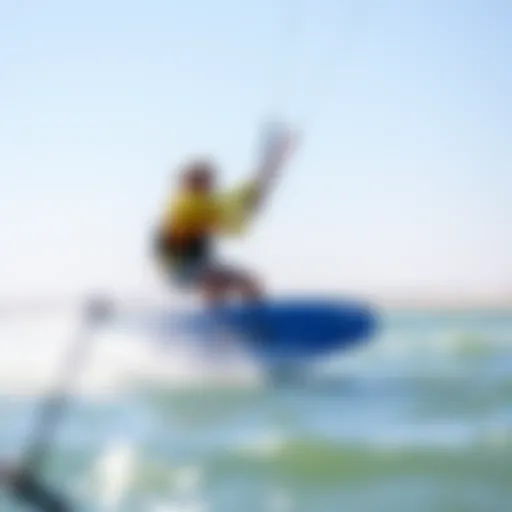Understanding Kiteboarding Costs: A Detailed Guide


Intro
Kiteboarding, an exhilarating blend of surfing and flying, draws enthusiasts from all walks of life, yet many often overlook one crucial aspect before diving into the waves — the costs involved. Understanding the associated financial commitments can make or break your experience in this thrilling sport. Whether you’re a newbie fantasizing about your first ride or a seasoned pro contemplating upgrading your gear, gaining a grasp on expenses is paramount. This article aims to peel back the layers of kiteboarding costs, providing insights that help you navigate the waters of budgeting effectively, making informed choices on equipment, and understanding the true investment you’re stepping into.
Gear Insights
Latest Gear Reviews
When it comes to kiteboarding, selecting the right gear is akin to choosing a reliable vehicle for a long road trip. The market offers a wide array of options, and without proper guidance, it can feel overwhelming. Recent evaluations of popular kites, like the North Vegas and the Duotone Rebel, have shown that high-quality models not only enhance performance but also provide better durability in varied wind conditions. Riders often rave about the North Vegas for its slick maneuverability and responsiveness, while the Duotone Rebel is praised for its versatility across skill levels and wind types. Dedicating time to read up on these comparisons can save you money and enhance your riding experience.
Essential Gear for Beginners
Starting out in kiteboarding doesn’t mean you need to empty your wallet. However, investing in essential gear is critical for your safety and enjoyment. Here’s what a beginner should consider:
- Kite: Opt for a suitable size for your weight and local wind conditions, which commonly ranges from 9 to 12 meters.
- Board: A twin-tip board is perfect for those new to the sport, offering stability and ease of use.
- Harness: A comfortable harness ensures you can enjoy prolonged sessions without fatigue.
- Safety Gear: A helmet and impact vest are highly recommended to protect yourself while learning.
Many local shops or online stores like The Kiting Company provide starter packages that bundle essential gear at a discount. Don’t hesitate to seek guidance; instructors can advise on the right kits tailored to your needs.
Techniques and Tips
Advanced Tricks and Techniques
Once you’ve mastered the basics, pulling off advanced tricks can skyrocket your enjoyment and skill level. Adding tricks like the kite loop or a backroll not only impresses your friends but also gives you a confidence boost. It’s crucial to practice these moves in safe conditions, ideally with a reliable buddy watching your back.
Safety Practices for Kiteboarders
Safety should never take a backseat, regardless of your experience level. Here are a few golden rules:
- Know the Area: Always be aware of your surroundings, especially wind patterns and underwater hazards.
- Check Your Equipment: Inspect lines and kites for wear and tear before you launch. A small tear can lead to bigger problems.
- Wind Conditions: Avoid going out if winds exceed your skill level.
- Take Lessons: Investing in lessons can provide you with invaluable knowledge about safety and equipment, ensuring you have a safe and enjoyable experience.
Kiteboarding opens a world of excitement, but understanding the costs and necessary precautions can make all the difference in your journey. With the right information and planning, you’ll not only ride the waves but also master them.
Prelude to Kiteboarding Costs
Kiteboarding, an exhilarating blend of surfing, snowboarding, and flying, is not just about the thrill of catching that perfect wind. It's essential to be mindful of the associated costs that come with pursuing this dynamic sport. Understanding the financial aspects can transform a sporadic hobby into a well-planned adventure that aligns with your budget and expectations.
The Importance of Cost Awareness
Being aware of costs in kiteboarding goes beyond just looking at gear prices. It encompasses every facet of the sport, from initial investments in high-quality products to ongoing costs that might sneak up on you. Awareness means you can gauge your options wisely—knowing when to splurge for that top-notch kite and when a more economical choice might suffice.
Cost awareness can help prevent unpleasant surprises later down the road. Kiteboarding involves various expenses that can impact your enjoyment if not planned well. For instance, the joy of hitting the waves can quickly turn sour if you realize too late that you’ve overspent on gear and can't afford travel to the best locations or lessons for proper instruction.
Budgeting for Kiteboarding: A Necessity
Budgeting isn’t just a plotting chart for expenses—it’s your roadmap to enjoying kiteboarding without breaking the bank. Establishing a budget for kiteboarding allows you to prioritize your spending. By dividing your budget into categories like equipment, lessons, maintenance, and travel, you place yourself in a better position to enjoy the sport responsibly.
Here are some key considerations to keep in mind:
- Initial Costs: This includes kites, boards, harnesses, and other essential equipment.
- Ongoing Expenses: Be aware of what it takes to maintain equipment, such as repairs and transportation costs.
- Instruction and Lessons: Budget for lessons to hone your skills, as these are critical for both safety and enjoyment.
- Unexpected Costs: Always set aside funds for those unforeseen financial demands.
In short, effective budgeting enhances your kiteboarding experience, allowing you to navigate the waters of costs with confidence and foresight. It's not merely about spending less; it's about making informed choices that yield the most enjoyment from your investment.
Initial Investment in Kiteboarding Gear
When embarking on the journey of kiteboarding, the initial investment in gear is a critical aspect that potential kiteboarders must carefully consider. This procurement sets the stage for not just the enjoyment of the sport, but also the safety and success of the individual. Investing in quality gear might pinch the pocket at the outset, but it can prevent unforeseen costs down the line and ensure a smoother ride.
Essential Equipment Breakdown
Kites
Kites are the heart of kiteboarding, acting as the vital link between the rider and the wind. These apparatuses come in various shapes and sizes, each designed to respond differently to wind conditions. When it comes to beginners, a delta-shaped kite often stands out due to its stability and ease of use. The key characteristic of kites is their versatility, allowing riders to adapt to various wind conditions and skill levels. However, the downside is that some kites can be quite pricey, which may cause some worried brows for first-time buyers.
It's essential to weigh the kite's durability and ease of control against its cost, as these factors significantly influence the overall kiting experience.


Boards
Next up are the boards, which serve as the foundation for every ride. In choosing a board, kiteboarders should consider factors like size, shape, and construction materials. The key advantage of a good kiteboard is its performance on the water. A well-designed board will allow for better energy transfer and maneuverability. Nonetheless, opting for a high-end board might stretch your budget considerably.
Many beginners start with all-round boards, as they offer a balance between performance and control. Many boards also integrate footstrap systems, enabling various riding styles. However, be aware that the cheaper options might not provide as much support or comfort as their pricier counterparts.
Harnesses
While often overlooked, harnesses are crucial for transferring the pull from the kite to the rider's body. They come in a few styles—mainly seat and waist harnesses. The distinguishing feature of these pieces of equipment is comfort. Comfort can greatly affect how long you stay out on the water, and an ill-fitting harness can ruin an otherwise perfect session.
Despite the upfront investment, a good harness can significantly enhance the overall experience by improving control and reducing fatigue. Just remember that it's vital to try on different types to find the right fit, as this can influence both performance and enjoyment.
Control Bars
Control bars are the interface between the rider and the kite, allowing for steering and adjusting kite tension. Each control bar will vary in terms of length, materials, and functions like safety systems. A critical aspect of choosing a control bar is compatibility with the kites being used. The right control bar should feel intuitive in the hands, allowing for quick adjustments without too much thought. One unique feature of modern control bars is the incorporation of safety leash systems that help release the kite in case of emergency. However, a drawback might be the added complexity, especially for beginners who might find various functions overwhelming. A careful assessment of control bar attributes could lead to a smoother learning curve for new kiteboarders.
Cost Variability Among Brands
The brand you choose can significantly impact your initial investment. High-end brands often promise superior quality, which can lead to less frequent replacements and greater durability. However, they may come with a steep price tag. On the other hand, lesser-known brands can provide more budget-friendly options but might compromise on aspects like reliability or performance. As consumers often say, "you get what you pay for," which rings true for gear in kiteboarding.
Researching and understanding various brands is crucial for making an informed decision that aligns with your budget and kiting aspirations.
New vs. Used Equipment Considerations
Making a choice between new and used equipment can be a tough nut to crack for beginners. Buying new gear ensures you're getting the latest technology and warranty but can take a hefty bite out of your budget. Conversely, used equipment often comes at a fraction of the cost but may carry wear and tear or obsolescence. Visiting local shops and community forums can provide insight into where to find reliable used gear. Additionally, checking online platforms can unveil some hidden gems from people who are upgrading or moving on from the sport. Finding the right balance between cost and quality is essential, and could lead to significant savings without sacrificing performance.
Ongoing Costs for Kiteboarding
Understanding ongoing costs is vital for anyone serious about kiteboarding. While the initial gear investment can be steep, it’s the ongoing expenses that often catch enthusiasts off guard. It’s crucial to recognize these costs to budget appropriately, ensuring a seamless kiteboarding experience as well as prolonging the life of your gear. Maintenance, storage, and travel expenses collectively form the backbone of a kiteboarder's financial investment. Let's break this down further.
Maintenance Expenses
Repairs and Upkeep
Repairs and upkeep are fundamental aspects of kiteboarding maintenance. Over time, your equipment is bound to face wear and tear, especially if you’re hitting the water regularly. A small tear in a kite can lead to bigger issues if not addressed promptly. Maintaining your gear not only boosts its longevity but ensures safety while you ride. A kite that hasn’t been well taken care of might compromise performance, leading to frustrating sessions.
When discussing repairs, consider the cost of urgency. A simple patch on a torn kite might save you from buying a new one, but delays can mean more substantial damage. The key characteristic here is preventing larger costs down the line. Having a regular check-up on your equipment, just like a health check-up for an athlete, can be a wise choice. On the flip side, keep in mind that repairs might not always be straightforward. Depending on how extensive the repair is, it can set you back financially if not planned for.
Replacement Parts
Replacement parts are another ongoing cost that kiteboarding enthusiasts need to keep on their radar. Over time, items such as control bars, harnesses, or even boards may need to be replaced due to extensive use or damage. Unlike repairs, which can sometimes buy you time, replacement parts mean investing in new gear to sustain your performance. The durability of kiteboarding equipment varies significantly from brand to brand, making it essential to choose wisely.
One notable characteristic of replacement parts is that they often enhance your experience. For example, upgrading to a more advanced control bar could improve responsiveness. However, this cost can add up, so consider shopping around or checking for second-hand options before committing to a brand-new piece. Understanding when to repair and when to replace is crucial for managing costs effectively.
Storage and Transportation Costs
Storing Equipment
Storing equipment properly, while sometimes overlooked, plays a significant role in kiteboarding expenses. Equipment left out in the elements can degrade quickly, inviting costly repairs or replacements. Whether you rent storage space or use your garage, ensuring your gear remains in good shape during off-seasons or when you’re not on the water is key.
The uniqueness here is that proper storage protects your initial investment. It also minimizes expenses related to repairs that arise from neglect. Those who think storing gear improperly won’t cost them might be in for a nasty surprise after a couple of months.
Traveling to Spots
Traveling to kiteboarding locations is where things can really add up. Whether you’re heading to a local beach or embarking on an international kiteboard trip, costs for gas, tolls, and potential accommodation come into play. In some cases, traveling involves flights where extra baggage fees for your kiteboarding gear can inflate your budget.
The key characteristic here is the balance between adventure and spending. While kiteboarding should be about enjoying the ride, the financial aspect can be daunting. A smart choice often comes down to planning. If you can find spots close to home or travel during off-peak seasons, you could save a pretty penny, letting you spend more time on the water instead of worrying about every dime spent.
Lessons and Professional Training Expenses
Understanding the costs associated with kiteboarding isn't solely about gear and travel fees; it also profoundly includes lessons and professional training. For newcomers, these lessons can be the cornerstone of ensuring not only safety but also a quick, enjoyable learning curve. Investing in quality instruction pays dividends, enhancing both skill acquisition and fostering an appreciation for the sport. The type of instruction you choose can directly impact your progress and ultimately your enjoyment on the water.
Types of Instruction Available
Private Lessons
Private lessons form a personalized approach to learning kiteboarding. These sessions typically cater to individual needs, allowing instructors to tailor the experience based on the learner’s skill level, previous experience, and specific goals. This one-on-one interaction can be very beneficial, especially for individuals who might feel overwhelmed in a group setting.
The key characteristic of private lessons is the dedicated attention and immediate feedback that students receive. This setup enables learners to grasp techniques swiftly and real-time corrections can significantly reduce the time it takes to become proficient. However, it's worth mentioning that private lessons often come at a higher financial cost compared to group classes. The exclusivity and personalized training are advantages, but students should weigh these against the potential strain on their budget.
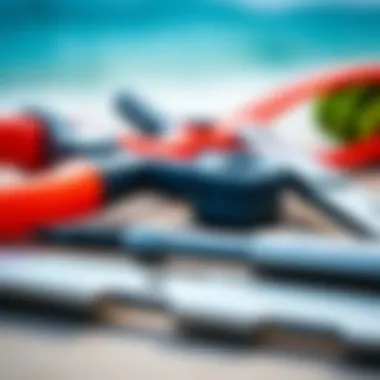
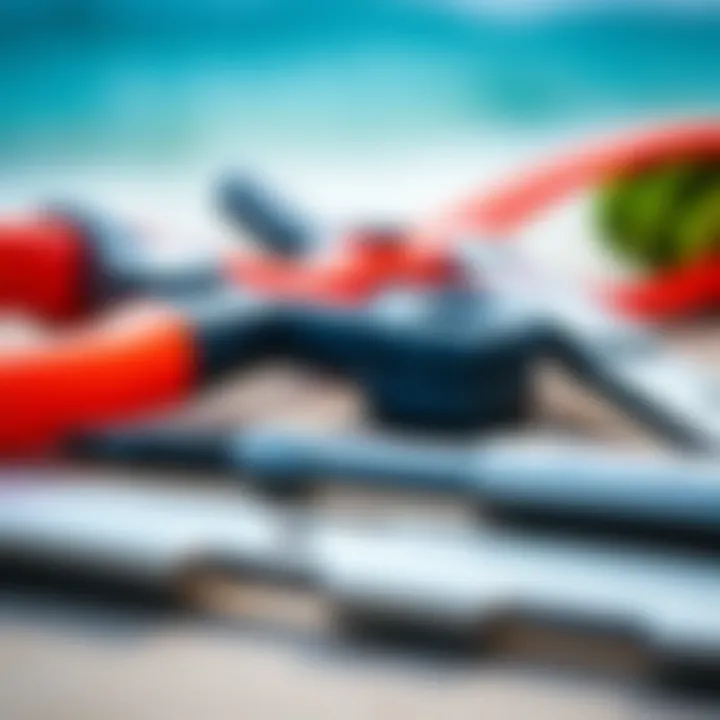
Group Classes
Group classes offer an alternative to private lessons, accommodating multiple learners at once. This type of instruction is popular among those looking to make friends within the kiteboarding community while learning. The key characteristic here is the social element; sharing the learning journey with others can make the experience more enjoyable and less daunting.
A unique feature of group classes is the opportunity for camaraderie. Students often support one another and share tips, which can enhance the learning process. However, with multiple learners, the instructor's attention might be diluted. This could result in longer periods between feedback for individual students and possibly a slower learning pace for some.
Online Tutorials
In today's digital age, online tutorials offer a flexible option for learning. Many kiteboarding schools and enthusiasts create tutorial videos covering everything from basic techniques to advanced tricks. The primary appeal of online tutorials is accessibility; they allow learners to progress at their own pace while revisiting complex techniques as often as necessary.
The key characteristic of online tutorials is the availability of resources, often at a reduced cost compared to traditional lessons. This option proves beneficial for learners in remote locations or those who cannot commit to scheduled sessions. However, a notable downside is the lack of immediate feedback. Without a trained instructor physically present, learners might develop bad habits that are difficult to unlearn later on.
Pricing Structures for Instruction
The pricing for kiteboarding instruction can vary remarkably based on the type of lesson and location. Generally, private lessons may range anywhere from $100 to $200 per hour, reflecting the exclusivity of one-on-one learning. Group classes are often more budget-friendly, ranging between $50 to $100 per person, depending on the size of the group and duration of the session.
Online tutorials can differ significantly; many are available for free, while more structured courses might charge a fee, typically between $20 to $100 depending on content depth and instructor expertise.
Ultimately, investing in lessons and training is a significant step towards enjoying kiteboarding more thoroughly. Understanding the varying types of instruction and their pricing will help aspiring kiteboarders make informed decisions that align with their budget and learning style.
Travel Costs to Kiteboarding Locations
Planning a kiteboarding trip isn't just about picking a spot where the winds blow right; it's about understanding the financial implications that come along for the ride. Travel costs can really add up, whether you're heading to a local beach or jetting off to some exotic destination. Ignoring these costs can put a serious dent into your overall budget for the sport. Let's break down the key elements of travel expenses, which can make or break your kiteboarding adventure.
Domestic vs. International Destinations
When it comes to choosing a kiteboarding location, the distinction between domestic and international can have significant effects on your wallet. Domestic destinations often provide more affordable options, as they eliminate hefty overseas flight tickets and potentially complicated visa requirements.
For instance, a weekend trip to the Outer Banks or Florida’s vibrant kiteboarding sites can allow for a quick escape without the financial hangover caused by long-haul flights. But, make no mistake, prices in popular domestic locations can inflate during peak season.
On the other hand, international kiteboarding locales like Tarifa in Spain or Cape Town in South Africa can offer some breathtaking riding experiences, but they come with various costs, such as:
- Flights: Prices can vary, with off-peak tickets usually being cheaper, sometimes leading to savings.
- Visas: Depending on your nationality, you may need a visa, which can add to your total.
- Currency Fluctuations: Payment conversion rates can impact prices, sometimes making things way more expensive than anticipated.
Ultimately, choosing between domestic and international travel boils down to your personal preferences, budget, and kiteboarding aspirations.
Accommodation and Local Expenses
After sorting your travel arrangements, the next layer of financial considerations falls on accommodation and local expenses. Depending on where you're kitesurfing, you might stumble upon a variety of options, from high-end resorts to budget-friendly hostels.
When evaluating your stay, it’s important to think about:
- Proximity to the Spot: Staying closer to the launch area could save you money on transportation costs. If you’re in the thick of things, you might actually bypass extra transportation altogether.
- Type of Rental: Consider group rentals or shared accommodations to minimize your costs. This way, you can experience camaraderie while keeping your budget in check.
- Local Amenities: Don’t forget to factor in costs associated with meals, gear storage, and additional activities. Dining at local markets or casual eateries can save a pretty penny compared to dining at tourist hotspots.
"Researching your local options can save you money, time, and maybe lead to discovering a hidden gem just off the beaten path."
As you plan, keep an eye on these aspects to ensure your kiteboarding experience is both exhilarating and cost-effective. Knowing how to navigate these travel costs is crucial not only for your wallet but for enjoying the thrill of the ride.
Insurance and Liability Costs
Understanding insurance and liability costs in kiteboarding can seem like navigating a tricky wind. However, knowing the specifics can spell the difference between peace of mind and financial turmoil. Kiteboarding, like many adventure sports, comes with inherent risks. From equipment failure to unexpected accidents, having proper coverage can save you from unexpected bills that could sink your budget.
It's crucial to remember that kiteboarding doesn't just pose risks to the rider. There's also the matter of public liability—if you were to unintentionally cause harm to someone else or damage private property while riding, the financial repercussions could be significant. This makes seeking out comprehensive liability coverage essential, especially if you're out on busy beaches or popular kiteboarding spots.
Ultimately, understanding these costs allows kiteboarding enthusiasts not just to budget well, but also to enjoy their rides knowing they are safeguarded against unpredictable events.
Types of Insurance for Kiteboarding
When it comes to insurance options for kiteboarding, there are several types to consider. Each type addresses different risks related to the sport and can provide varying levels of protection:
- Equipment Insurance: This covers damage or loss of your gear in case of theft, accidents, or natural disasters. Given the hefty price tag of quality kiteboarding equipment, this type of policy can be invaluable.
- Liability Insurance: This insurance is designed to protect you from claims made by others for accidents that occur while you're kiteboarding. It might cover injuries to bystanders or damages to property.
- Accident Insurance: If you suffer an injury while kiteboarding, this can help with medical expenses. It’s a protective cushion for those who want to be prepared for the unexpected.
- Personal Injury Insurance: This is often included in accident insurance, but it can offer broader protections including rehabilitation expenses.
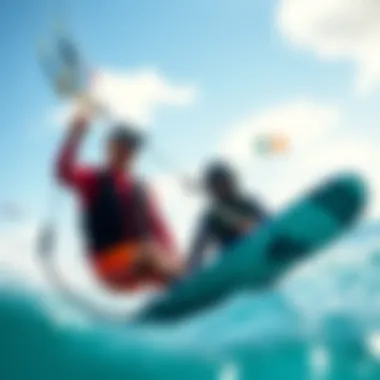
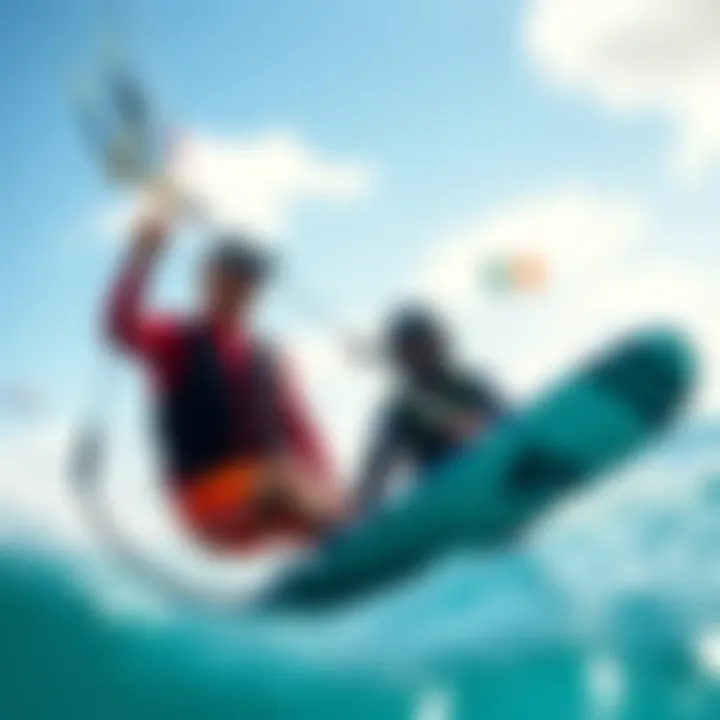
Researching each option thoroughly ensures that you are not left exposed when the wind takes a turn.
Assessing the Need for Coverage
Determining how much coverage you need for kiteboarding hinges on a few factors. Firstly, consider the frequency of your kiteboarding activities. If you hit the waves every weekend, it might be wise to invest in comprehensive coverage compared to someone who boards only a few times a year.
Another factor is your location. If you often ride in crowded spots, you may want to lean more toward liability insurance. Furthermore, think about your skill level. Beginners may face heightened risk due to less experience, which means greater potential for mishaps.
A good practice is to evaluate:
- Your Equipment's Value: Knowing what your gear is worth helps tailor your insurance needs.
- Travel Habits: If you frequently travel to different locations to kiteboard, consider whether your insurance covers international incidents or just domestic ones.
- Risk Tolerance: Are you comfortable shouldering more risk or do you prefer to pay a bit more for peace of mind?
In summary, assessing the need for insurance is about evaluating where you stand as a rider. Investing in adequate coverage reflects not only on prudent financial decisions but also on valuing your adventure without unnecessary worries.
Financial Considerations for Kiteboarding Enthusiasts
Kiteboarding isn’t just about the thrill of zipping over water, catching air, and mastering the wind. When you're gearing up for this exciting sport, understanding the financial implications is just as vital as picking the right kite or board. Financial considerations play a pivotal role in ensuring that you don’t break the bank while chasing the waves. This section looks at ways to evaluate your budget effectively and pinpoints strategies to save without compromising on quality or safety.
Evaluating Your Budget
Before diving headfirst into kiteboarding, assess your financial situation. Start by listing all your potential costs, from gear acquisition to travel expenses. Get a grip on how much you can realistically spend on kiteboarding without losing sight of your other financial obligations. A well-drafted budget should include:
- Initial gear costs: What's your budget for kites, boards, harnesses, and control bars?
- Ongoing expenses: Maintenance, storage, and potential repairs can add up quickly.
- Lesson fees: Decide whether you’ll opt for private instruction or group classes.
- Travel costs: Think about distances to the best kiteboarding spots and what those trips might cost.
Once you have a handle on these numbers, you can make smarter decisions about which equipment to buy, how often you’ll invest in lessons, and where to go for your kiteboarding adventures. Being realistic about your budget keeps your kiteboarding journey enjoyable and free of financial stress.
Cost-Saving Strategies
Keeping your finances in check while embracing kiteboarding can seem daunting. However, savvy kiteboarders utilize several cost-saving strategies to keep expenses down. Here are two popular tactics:
Buying Off-Season
One of the simplest ways to save money in kiteboarding is to buy gear during the off-season, which typically falls in the fall and winter months. Retailers often slash prices during these periods to make room for new inventory. This not only presents a key advantage—you can snag high-quality equipment without burning a hole in your wallet—but also allows you to be prepared well in advance for the next riding season.
However, there’s a unique feature to consider: while prices are lower, the selection may be limited compared to peak season. You might miss out on the latest models or your preferred colors. Still, for budget-conscious enthusiasts, buying off-season is a popular choice that provides excellent value for the equipment.
Community Rentals
Another strategy that many kiteboarders find beneficial is utilizing community rentals. Many coastal areas have kiteboarding clubs or community centers that offer rental gear at reasonable rates. This not only saves you from the hefty upfront costs of buying gear, but it also allows for trying various equipment without the commitment.
A standout characteristic of community rentals is that you can often access well-maintained equipment, as local clubs are usually diligent in keeping their gear in good shape. However, the downside may include limitations on the type of gear available, especially if you’re looking for a specific brand or model. Thankfully, this strategy lets newcomers dip their toes in the sport without diving into significant financial commitments from the get-go.
"Kiteboarding is a thrilling journey, and managing costs smartly can elevate your experience without the dread of overspending."
In summary, understanding your financial needs and employing effective cost-saving strategies are essential for a stress-free kiteboarding experience. Navigating these financial considerations thoughtfully allows you to focus on what truly matters—the joy of soaring over the water, mastering the winds, and enjoying your adventures.
Epilogue: Understanding Your Investment
As we draw the curtain on our detailed exploration of kiteboarding costs, it's vital to underscore the broader implications of understanding your investment in this exhilarating sport. Kiteboarding, though frequently perceived as a leisure activity, requires a level of fiscal prudence and awareness that can significantly enhance your experience. The journey doesn’t end after you’ve made the initial purchase of gear; rather, it begins anew as you navigate ongoing expenses, travel fees, and additional training costs.
The real value of kiteboarding transcends the tangible elements of gear and lessons. While price tags can be off-putting at first glance, it’s crucial to look at the bigger picture. Consider these key elements:
- Skill Development: Investing in quality training can yield dividends over time, as mastering kiteboarding not only enhances safety but also extends enjoyment and proficiency.
- Connection with Nature: The opportunity to engage with serene landscapes, oceans, and lakes offers a priceless mental escape from the grind of daily life. This connection is enriching and therapeutic.
- Community Aspect: Kiteboarding creates avenues to meet new people, form friendships, and experience a sense of belonging within the kiteboarding community. This camaraderie can enhance your journey both on and off the water.
Understanding the full scope of your investment allows you to budget more effectively, enabling a greater focus on the passion of kiteboarding rather than on finances.
The Value of Kiteboarding
The value of kiteboarding lies not just in its physical activity, but in the multifaceted benefits it provides. It combines adventure, fitness, and relaxation in one unique package. Physically, it helps build strength, endurance, and improves balance and coordination. Beyond the muscle, the mental benefits can be profound. Many kiteboarders report feeling significant stress relief and increased happiness after a day on the water.
Moreover, participating in such an engaging sport often leads to a healthier lifestyle overall. Regular engagement with kiteboarding can encourage individuals to maintain fitness levels required to enjoy the sport safely. This translates into a more active life where participants are often inclined to seek out other adventures and opportunities that a sedentary lifestyle might not afford.
Making Informed Financial Decisions
Grasping the financial aspects of kiteboarding is essential for making informed decisions. Understanding the costs associated with different elements of the sport—from equipment and lessons to travel—can help individuals allocate their budget wisely. It’s not just about finding the lowest price; it’s about investing in quality and safety.
When considering how to budget for kiteboarding, keep the following in mind:
- Prioritize Gear Quality: Quality equipment can last years and significantly enhance your experience.
- Look for Deals in Off-Season: Many retailers offer significant discounts on last season’s gear, which could be a savvy way to save money.
- Renting versus Buying: For beginners, renting equipment can be a practical approach until you’re certain about your commitment to the sport.







